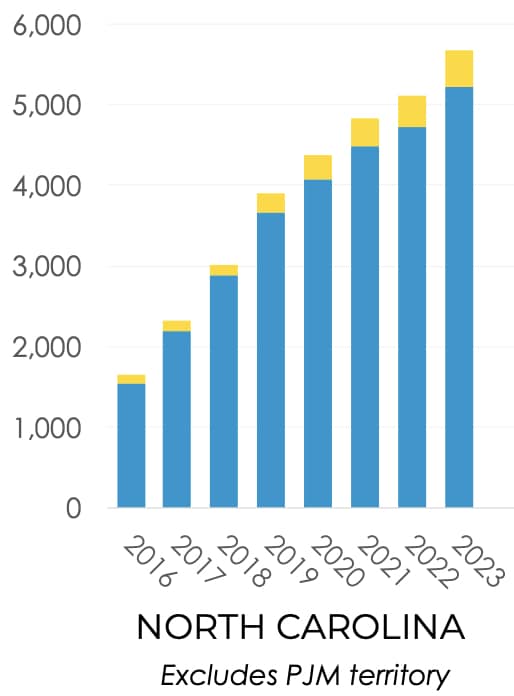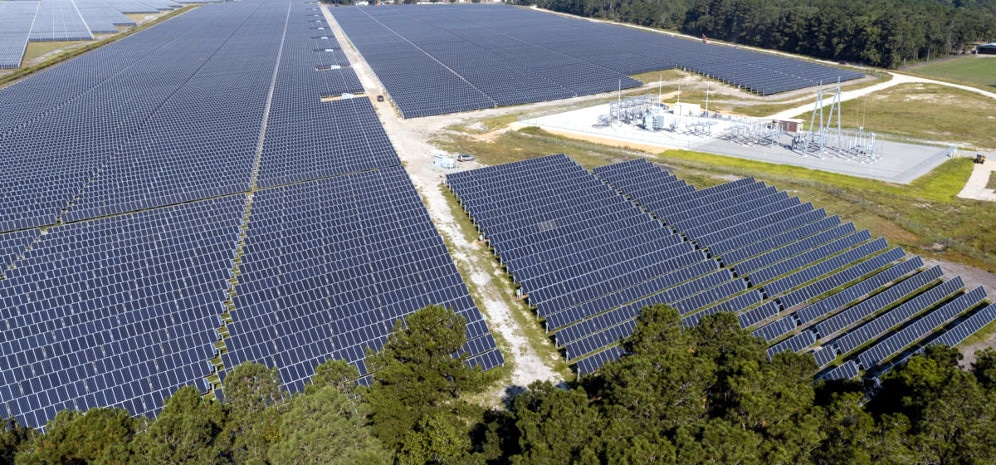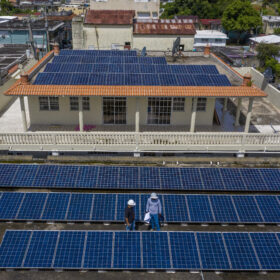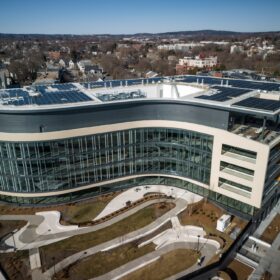To help clear a backlogged interconnection queue, as ordered by North Carolina regulators, Duke Energy has proposed a plan for “cluster” processing of utility-scale solar interconnection applications. Under Duke Energy’s current one-at-a-time process, the queue would take “decades” to process, a Duke witness estimated last year.
North Carolina’s solar developers and clean energy businesses “are generally supportive” of Duke’s queue reform plan, they said in comments filed with regulators, and recommended improvements aimed at ensuring fairness and limiting the burdens on interconnection customers.
Duke Energy’s utilities in North and South Carolina had 14 GW of solar and wind projects in their interconnection queues last year, when a Duke witness testified that “because the interconnection queue and study complexities continue to increase, the current serial study process is not sustainable.” The North Carolina Utilities Commission quoted the witness as witness Freeman, in the Commission’s June 2019 order to Duke Energy to engage with stakeholders to discuss queue reform.
It would “likely require decades to serially study and potentially connect” the projects in the queue, the witness added.
“An increasing number of regional transmission organizations (RTOs) and utilities” in other areas of the country use “a cluster study process,” the NCUC quoted the witness as saying; the witness added that Duke believed it needed to switch to a cluster study process.
A cluster study process—a form of batch processing—could also fix another key problem. North Carolina regulators said that witness Freeman “explained that when larger network upgrades are triggered by an interconnection request, the serial study process results in large upgrade costs being assigned to one project even though it is extremely unlikely that a single project could absorb such significant cost.”
The current approach of serial processing “will result in paralysis in certain areas,” the regulators wrote, “as project after project will be forced to withdraw from the queue.” In cluster processing, those costs could be assigned to a set of projects that would all benefit from the upgrade.
 Duke Energy Carolinas said in a 2019 stakeholder presentation that “2019 interconnections [were] lower than expected in 2018 IRP.” Interconnection delays in North Carolina will slow the state’s pace of solar installation, the Southern Alliance for Clean Energy has projected, as shown in the graph at right (showing utility-scale solar in blue).
Duke Energy Carolinas said in a 2019 stakeholder presentation that “2019 interconnections [were] lower than expected in 2018 IRP.” Interconnection delays in North Carolina will slow the state’s pace of solar installation, the Southern Alliance for Clean Energy has projected, as shown in the graph at right (showing utility-scale solar in blue).
Improvements
Some improvements in Duke’s queue reform plan recommended by solar developers were to conduct more than one cluster study process per year, reduce the time limits for various stages of each study, reduce deposit amounts, and eliminate a provision that would favor Duke-owned projects that Duke has selected in a resource plan.
Developers also recommended that Duke promptly complete interconnection reviews for third-party owned renewable generating facilities, to meet the timeframe set by state law. Given the expected step-down in the federal investment tax credit, and the state law’s cap on power purchase agreement (PPA) prices at the avoided cost rate, a delay “could wholly obstruct the achievement of the renewable procurement target established in House Bill 589,” they said.
The solar developers also flagged “huge bills for cost overruns relating to construction of interconnection facilities and network upgrades,” which have been documented in “numerous complaints against Duke.” The developers said they had provided Duke a “reasonable cost control and cost bounding proposal … that Duke is in the process of considering,” and noted that Duke has “demonstrated a willingness to work constructively” with stakeholders, adding that they looked forward to further collaboration.
PJM’s approach
The PJM grid region, which extends into a portion of North Carolina, last year published a planned timeline for batch processing of interconnection applications, showing construction beginning two years from the middle of each six-month queue window:

Solar developers made their comments on Duke’s proposed queue reform plan in a joint filing by the North Carolina Clean Energy Business Alliance, and the 375-member North Carolina Sustainable Energy Association. The filing also details the two groups’ involvement in Duke’s stakeholder process.
Duke Energy operates in North Carolina through two subsidiaries: Duke Energy Carolinas and Duke Energy Progress.
This content is protected by copyright and may not be reused. If you want to cooperate with us and would like to reuse some of our content, please contact: editors@pv-magazine.com.







By submitting this form you agree to pv magazine using your data for the purposes of publishing your comment.
Your personal data will only be disclosed or otherwise transmitted to third parties for the purposes of spam filtering or if this is necessary for technical maintenance of the website. Any other transfer to third parties will not take place unless this is justified on the basis of applicable data protection regulations or if pv magazine is legally obliged to do so.
You may revoke this consent at any time with effect for the future, in which case your personal data will be deleted immediately. Otherwise, your data will be deleted if pv magazine has processed your request or the purpose of data storage is fulfilled.
Further information on data privacy can be found in our Data Protection Policy.